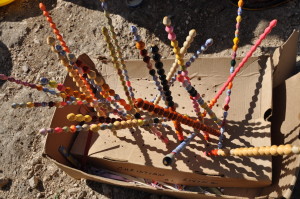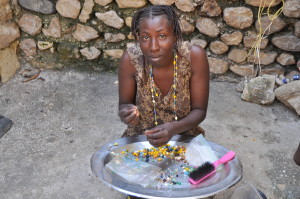Over the past 6 years we have received thousands of boxes full of empty cereal boxes from churches, schools, afterschool programs, homeschool families, nursing homes, and just people who collect as a family. We can go through 400 cereal boxes per day! What is the story there? How did we fall into this insatiable need for cereal boxes. Why are we importing “trash” into Haiti anyways?
Here is the story.
In the summer of 2009, we had just moved in to our own place after living in the orphanage and had identified a few women who were “at risk” for losing their children to orphanages. I had a summer intern (Kelsey) at the time who was game to help me and she invited the ladies to come over to the house twice a week and taught them some basic jewelry making skills- earrings and bracelets. We were running downtown to the iron market (Marche an Fer) to buy whatever beads we could find locally- mostly wood beads and seeds and Kelsey was doing an awesome job of teaching and figuring out how we could get the items back to the states to sell. Facebook was fairly new to me at the time and I started marketing some of the jewelry on social media, hoping that we could make a few sales that way.
Kelsey went back to college (Judson University) in the fall and the ladies were continuing to make these trinkity little pieces that we were selling, but it seemed that we needed something a little bit more interesting to keep the sales going. My mother had been up to Alaska to visit my brother where he was stationed with the Air Force, and she had wandered into a “fair trade” store with my sister in law that was selling paper bead jewelry from Africa. She told me about it and I decided to try it out. I sat around for the next few weeks cutting up paper with scissors and rolling hideously ugly beads and varnishing them with fingernail polish. The ladies looked at me like I had lost my marbles and wondered why we couldn’t buy the perfectly good beads from the local markets instead of making these hideous attempts that were time consuming, messy, and ugly.
Along with the women we were helping, we had a little outreach to the street kids in our neighborhood where we would invite them over for cartoons and lunch once a week. A few of them started to come over more to hang out and ended up being staple visitors at our house. Three boys in particular, Rodney, Leo, and Little Richard were over at our house the most and they saw my feeble attempts at paper beads and seemed game to try it out. They succeeded at making them and seemed motivated and so I decided that since they were willing to work, that I would help them sell their own jewelry as well so that they could afford to go to school. Within a month the boys sales with the paper beads tripled the ladies sales with the normal beads and of course, the ladies quickly got on board with the paper beads.
 The one thing that bothered me was the similarity of what we were making to what I saw coming out of Africa. I really wanted to do something that distinguished us from the African handicraft, so I started experimenting with different material. I remember distinctly this one present I had bought for my daughter for Christmas that had a lightweight pale blue box. We cut the box up and rolled these really cool blue chunky beads our of the cardboard and made necklaces out of it. At the Christmas fair that we went to that year at my kids school, those chunky blue necklaces sold out instantly. I felt like I was on to something and so was trying to figure out what other items came in lightweight cardboard. The answer was cereal. Cereal boxes.
The one thing that bothered me was the similarity of what we were making to what I saw coming out of Africa. I really wanted to do something that distinguished us from the African handicraft, so I started experimenting with different material. I remember distinctly this one present I had bought for my daughter for Christmas that had a lightweight pale blue box. We cut the box up and rolled these really cool blue chunky beads our of the cardboard and made necklaces out of it. At the Christmas fair that we went to that year at my kids school, those chunky blue necklaces sold out instantly. I felt like I was on to something and so was trying to figure out what other items came in lightweight cardboard. The answer was cereal. Cereal boxes.
We started collecting and cutting up cereal boxes locally and making chunky bead necklaces and things took off. People were lining up to have us train their people how to make them as well and before we knew it, we were seeing cereal box beads all over Haiti. Today you can find them from Cap Haitian in the north all the way to Jacmel in the south. It always makes me smile when I see cereal box beads as I feel like an insider on a tiny secret of how they came to be.
Today our artisans can go through 400 boxes per day. The color variation that we require and quantity that we need can’t be found in Haiti, so we had to start appealing to people to bring us empty cereal boxes to help us produce. It has become a way for people in North America to get involved and become a link in the chain of empowerment for these artisans. Each individual artisan can roll upwards of a thousand beads per day and it has put us on the map as a production and export company in Haiti. Although we have expanded and work more and more with clay at this point in our evolution, the cereal box is a staple and a tradition for our business and has a fond place in my heart.
Many people ask how I got to where I am now with the business. I really want to communicate to people who ask this question that it really wasn’t any special training, business plan, or huge vision that predetermined where we ended up, but just the everyday faithfulness to the hope and mission that moms could have jobs and the willingness to keep trying new things until it worked out. I didn’t set out to create a huge company, but rather I just set out to create one job at a time.

(This picture is of Jaqueline- one of our original 10 artisans. She had two beautiful boys and worked for us for 5 years before she suddenly passed away from congenital heart failure in her mid 30s. Old age diseases are very common in midlife in Haiti because of malnutrition and harsh living conditions. After she died, I hired her husband to make clay so that he could continue to take care of the two boys. They are all doing well but I miss Jaqueline every day.)
